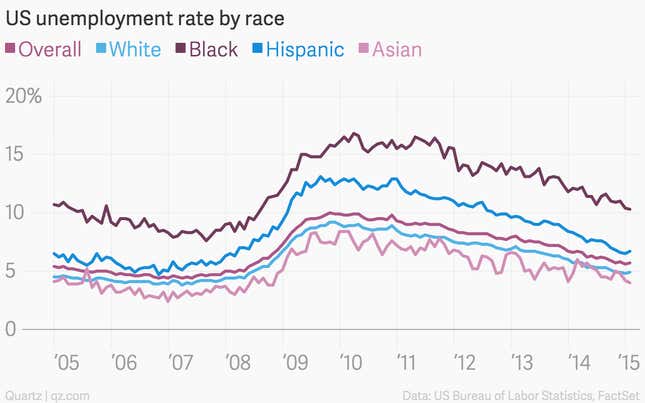A quiet change in the US jobs report will make life much easier for policy wonks and advocates tracking American unemployment by race and ethnicity.
In a couple of footnotes to the most recent report, the Bureau of Labor Statistics announced changes to the racial breakdowns in the labor figures it releases each month: Seasonal adjustments will be coming for Asian workers and a broader swath of Hispanic demographics, specifically men over 20, women over 20, and teens.
Seasonal adjustment is the process that smoothes out bumpy month-to-month figures to account for things like weird weather and holidays. The BLS already tracked unemployment for Hispanic teens and Asians, but it didn’t adjust the monthly figures—while white and black teen unemployment or Hispanic unemployment overall, for instance, got the seasonal treatment. The only time the report did adjust for these groups was in an annual report that would show characteristics for the entire year.
That’s the reason the Asian line on this chart is so much more jagged than the others:

Because of that jagged line, those looking closely at a particular group’s rates would sometimes find themselves misled, said Catherine Singley Harvey, the program manager for the Economic and Employment Policy Project at the National Council for La Raza, who said she is excited to use the new stats in her work tracking Hispanic youth unemployment, among other things.
“Without seasonal adjustments, we would read too much into fluctuations month-to-month,” she tells Quartz. It’s not that the earlier numbers were inaccurate or impossible to use in analysis, she explains, but “you’re not really looking at apples to apples.”
The new data is possible because of a change the BLS made in 2003 to the Current Population Survey, which informs the jobs report, to better account for race and ethnicity. But the agency didn’t start using the answers immediately. It took some time, explains Thomas Evans, a mathematical statistician for the BLS, because “we need to have several years and enough data to do the seasonal adjustment.”
The new numbers go back to 2003 on the BLS’s website, offering some context. “That allows us to compare across subcategories what’s going on in youth unemployment,” Harvey told Quartz.
